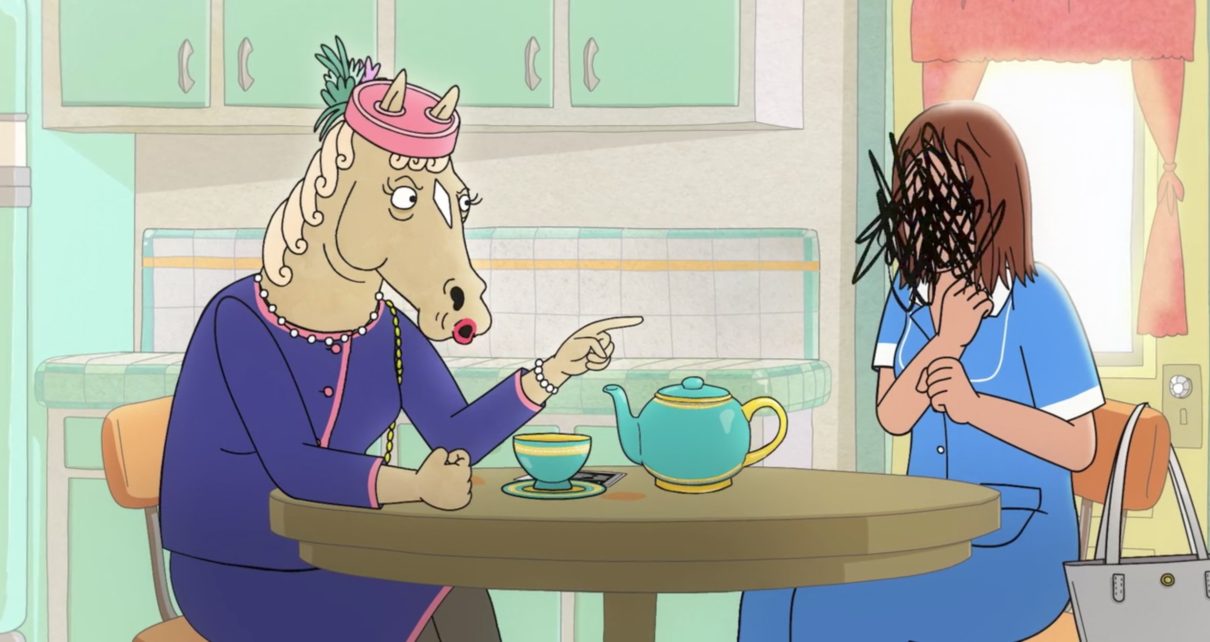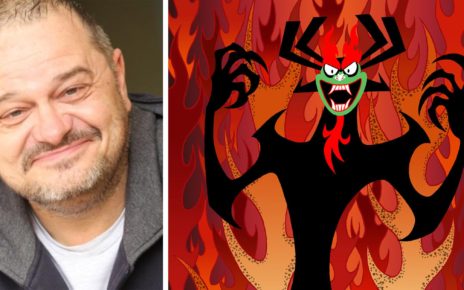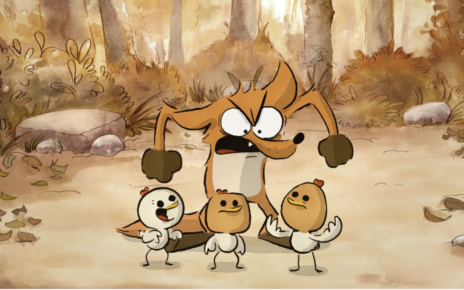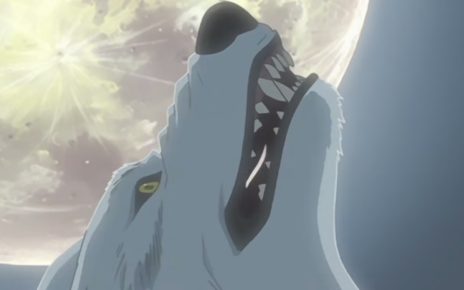
This post contains spoilers for BoJack Horseman Season 4.
Initially, it was just a normal playground slide, James Bowman says, walking through the steps of the creative process behind BoJack Horseman’s climactic, penultimate season four episode, “Time’s Arrow.” It’s about Beatrice Horseman’s entire life leading up to the onset of her dementia, and she’s replaying all of it. All the time.
“Then we thought, ‘Hey, this is in her mind!’” he says. “As a little kid, she probably remembers the slide being super, super high, and the fall being that much worse. So then we went ahead and made this ridiculous slide.”
It’s a tiny detail, but it’s exactly the kind of element that makes BoJack Horseman one of Netflix’s most beloved andadmired series. Bowman got his start working on BoJack as the show’s third season was throttling into production. He had previously worked on another show made by Los Angeles–based production company ShadowMachine, which is responsible for BoJack, when supervising director Mike Hollingsworth hired him as a storyboard artist. “I really appreciate him,” Bowman tells The Dot and Line; Hollingsworth offered him, a longtime animator, a chance to work on one of the most widely acclaimed adult cartoons in America.
To Bowman’s mind, Hollingsworth saw something: “He hand-picked me special for [production number] 304, the ‘Fish Out of Water’ episode.” That episode, of course, changed much of the conversation around the show. BoJack Horseman was always a well-animated, intelligently written series, but “Fish Out of Water” took place underwater, almost entirely in silence, rolling influences from both Looney Tunes and Lost in Translation into a tight, funny, and uncharacteristically warm-hearted half-hour that told the story of BoJack bringing a child back to its family. “Everyone knew it was our Fantasia,” producer and production designer Lisa Hanawalt told Vox when it came out. It benefited from a lengthy production cycle and the willingness on the part of its creators to do, in Bowman’s words, “whatever we can do to make it better.”
If you liked this story, sign up for our newsletter.
Obviously, they had to top it when the next season rolled around.
If this month’s reviews, analysis, and shell-shocked Twitter reactions are any indication, the new season of BoJack Horseman exceeded even those expectations. Bowman, now one of the show’s assistant directors, says the production team is better-equipped than ever to tell a beautifully animated story. For a “Prestige TV” animated series, that means making a concerted effort to regularly execute on crazy ideas — not just in the eleventh entry of a 12-episode Netflix order, but throughout the run. It means ever more conversations with the animation companies in South Korea that help produce the show to ensure that everything looks polished, and it means re-animating sequences that don’t meet the show’s high standards. Through it all, it means staying true to your characters’ interior lives, whether they’re thinking coherently or slowly and tragically losing their memories. It’s not easy.
“Particularly this fourth season, the machine is finally well-oiled,” Bowman says. “It really felt that way.”
The bar set by “Fish Out of Water” was high. That season three bottle episode was unique in that his bosses decided to devote a full season’s production cycle to work on it. (It’s kind of like how Born to Run the album took a year to record and produce, but “Born to Run” the song took six months—but longer, because this is animation we’re talking about.)
“This season they did try to be a lot more ambitious,” Bowman says. And no one who’s watched BoJack since it first premiered in 2014 would assume that it wouldn’t try to top itself. Visually, it’s come a long way since season one, when, according to Bowman: “The executive producers had in their minds what they wanted the show to look like: staged like a sitcom, a multi-camera sitcom.”
“That’s why it’s really just kind of flat-looking” in the early episodes, he says. “More and more, as each season goes, it’s looking less and less flat. Especially after the success of the ‘Fish Out of Water’ episode, they wanted to do a lot more experimentation this season.”
That can make things more challenging, but also more exciting for the animators. Several episodes of season four show off beautifully discrete animation styles particular to individual episodes, flashbacks treated in wildly different ways depending on which characters lived through them, and massive crowd and party scenes — which mean more faces and characters that storyboard artists and animators need to keep consistent.
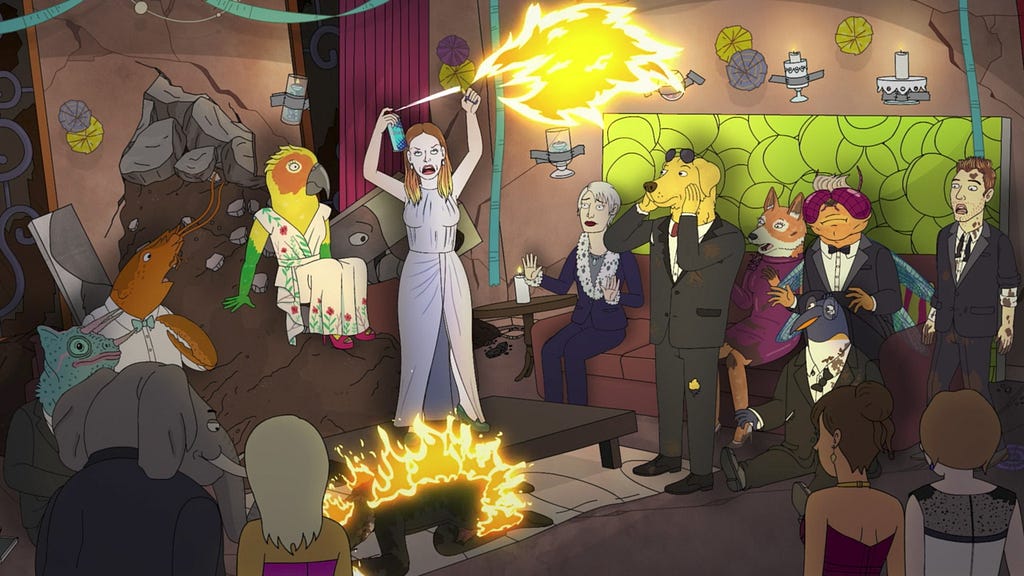
That problem presented itself in “Underground,” another ambitiously scripted and animated episode in which Mr. Peanutbutter’s support for fracking as a gubernatorial candidate causes the earth to cave in beneath his house, which plummets into a newly-formed cavern during the middle of a fundraising gala. The episode takes place entirely underground in a home filled with famous guests, including Zach Braff and Jessica Biel guest-starring as fictionalized versions of themselves. (At one point, Biel sets Braff on fire as the oxygen underground begins to run out.) All the while, the cast in the background reacts to the horror in front of them. “That was a really, really, really challenging one to storyboard,” Bowman says. “Primarily because every shot, almost, is a crowd scene.”
“You have to squeeze all those people into such a small space,” he explains. “You have to make sure that they’re alive and moving. It was a really labor-intensive episode.”
There’s another layer to the production cycle most casual viewers probably don’t realize, too. It’s not just that each character needs to be drawn with precision. Storyboard artists have to account for a Korean language barrier and the quality standards of a show that’s often compared to the meticulous direction of Mad Men.
Here’s how it works: When it comes to the animation process, each episode of BoJack starts with a script. The script gets outlined in the “thumbnail” phase, when directors lay out visually (with thumbnail illustrations) what their episodes will look like, and producers and writers agree on that. Those thumbnails then get storyboarded, where artists and assistant directors like Bowman sketch and finalize all of the scenes’ action in a series of shots and sequences. The storyboards get sent to South Korea to be animated and rendered. “When you send them to Korea, you can’t leave any room for misinterpretation,” Bowman says. “You’ve got to make sure they’re animating the correct character, or it needs to be done again.”
“You can’t just swap them out,” Bowman adds. Those are the limits of animation and why it takes so much time to create fluid, coherent visuals for a show like BoJack Horseman. Ideally, Bowman says, “you make your storyboards really, really tight, so they don’t make any mistakes.” Should mistakes find their way into the deliverables from Korea, or the animation just doesn’t look up to snuff, there are a couple of different fallbacks.
One: “If it’s not quite right, or they misinterpreted something, or it’s not animated to our expectations or something, we give them notes, send it back,” Bowman says. “They’ll get a chance to fix it and animate it again.”
And two: “Then it comes back to us [in L.A.], and if it’s still not right, then it goes to us, the retake animators, who make it look good and the way that we want it to.”

Retake animation is Bowman’s second job on the BoJack team. Retake animators are responsible for re-animating specific shots in episodes in order to clean up errors. In the United States, retake animation teams aren’t all that common among most contemporary primetime animated series, Bowman says. The process on other shows involves more back-and-forth dialogue with animators in Korea: “If they do it wrong, you send it back, If they still do it wrong, you send it back again. You just keep [going] until they animate it [right].”
The small team of retake animators speeds that process up by eliminating some of the coordination with contractors on the other side of the world. Also, they’re not tasked with re-animating entire episodes—just specific shots—which makes the process less time-consuming.
One adjustment to the usual process that made the production of season four even easier involved sending a representative from the team in California to speak face-to-face with the team in South Korea. “He worked in Korea to help with the translation process,” Bowman says. When it came to nailing the animation, compared to earlier seasons, “there wasn’t as much of a language barrier.”
For Bowman, the return on that investment spoke for itself: “It was a lot better animation than ever—a lot more polished, a lot more of what we were looking for.”
You need only look at the staff of the retake animation team between seasons three and four to tell the difference that made, Bowman says. “At one point there were like eight animators” on the retake team in season three. “This season, it was, like, half that.”
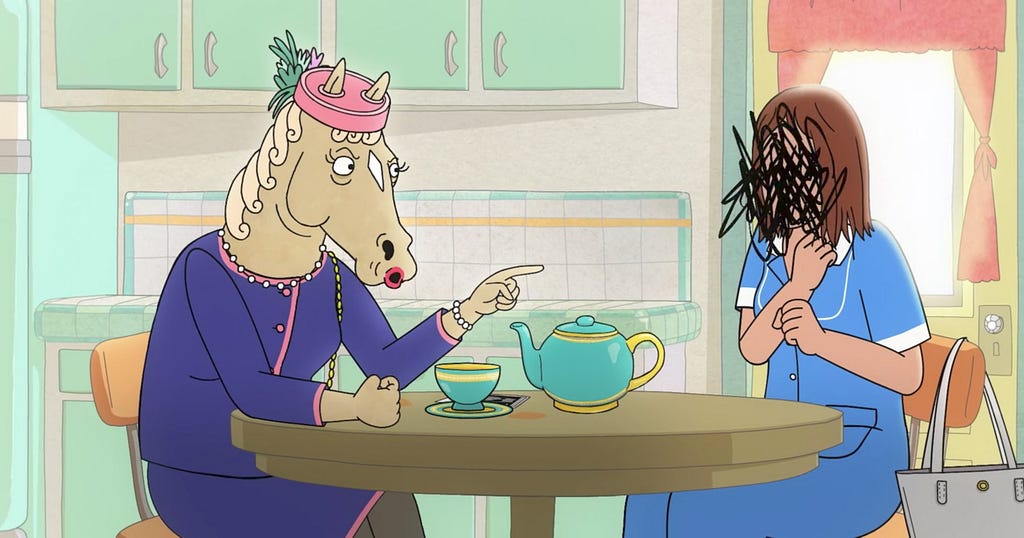
All of that effort results in one of the most significant animation achievements of this century, which land in binge-able batches that, by now, diehard fans are cultured to consume immediately. By the time season four rolled around, BoJack Horseman was already a critical darling and a show that forced its viewers to think. BoJack is, on its face, a witty sitcom about a washed-up actor who happens to be a horse, but it’s also a show that tackles addiction, depression, narcissism, and the emotional fallout of ignoring the needs of others in order to feed your own bottomless demons.
Which brings us back to “Time’s Arrow,” an episode that attempted to dunk the audience headfirst into the mind of the show’s most world-wizened character: BoJack’s abusive mother, Beatrice Horseman, who is quickly succumbing to dementia. If some of the most poignant sequences of “Time’s Arrow” seem Chuck Jones–influenced, scattershot, and erratically animated, rest assured, it was all intentional. From the outset, Bowman says, the goal was to yank the audience through the difficult ravages of time and life, and to do that with respect to Beatrice’s interpretation of events: “It all goes through Beatrice’s eyes, her lens.”
It’s why the reveal of Henrietta Platchkey’s identity as Beatrice’s maid, and as the name that she’s been calling BoJack for the entire season, hits so deeply hard. “She has a negative memory of Henrietta there. Her face is scribbled out,” Bowman says. “The audience never knows what this character looks like.” That was the supervising director Mike Hollligsworth’s idea. It’s also why you don’t see the faces of a ton of background characters in crowd scenes — a noticeable omission thanks to the show’s typical attention to detail in that arena. “They were there, but they weren’t really important to her,” Bowman says.
Bowman doesn’t elaborate much on the meaning behind it. The effect of watching the multi-decade misery (and ultimate desire to do good) inflicted upon a woman’s psyche erode into nothingness as her son, who hates her, tells her that she’s not in a crappy nursing home but instead on a lake in Michigan eating ice cream with her long-dead brother…it speaks for itself. All the same, Bowman and storyboard artists and animators like him are responsible for creating whatever you feel when you watch either a heavy or lighthearted episode of BoJack. They craft the mood of the show. They drive the action and the pacing of scenes and sequences. The background and storyboard artists even write the vast majority of the background gags and sight puns. (“Hollingsworth is a wizard of animal jokes and puns that happen in the background,” Bowman confirms. “It’s like another language that he speaks, basically.”)
The irony is that when you’re involved with the production on that level, Bowman explains, you might not actually watch the final, finished cuts of episodes until they drop on Netflix. In our conversation, Bowman says he had only seen the finished visuals for the episodes he was doing retake animation on.
“It’ll be pretty cool to see what this season’s fully about and what it looks like,” he says. “It’ll be new stuff for me, too.”

Thanks for reading The Dot and Line, where we talk about animation of all kinds. Feel free to follow us on Twitter and Facebook.


